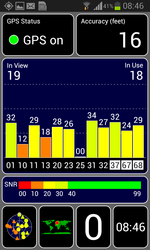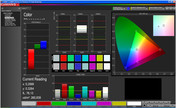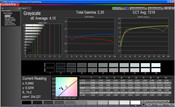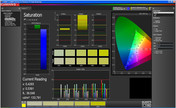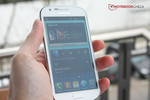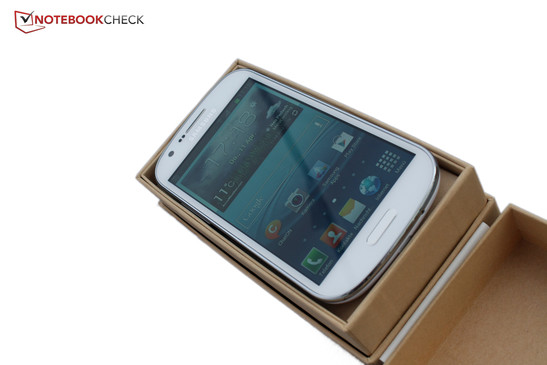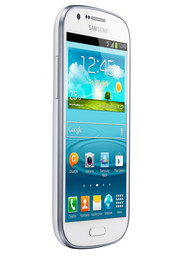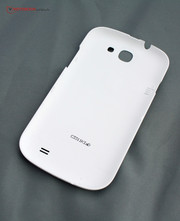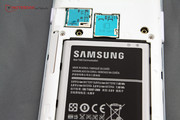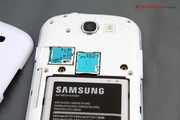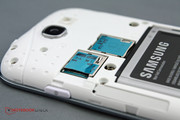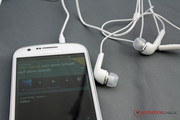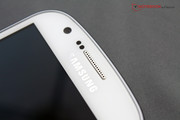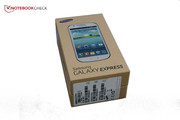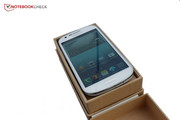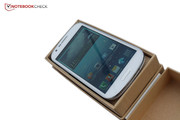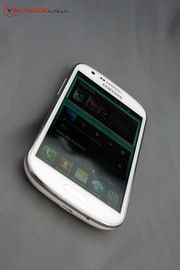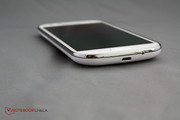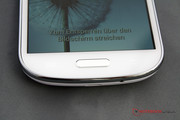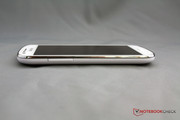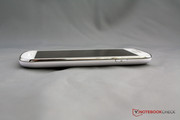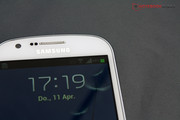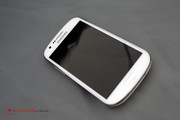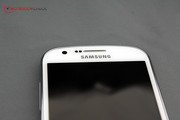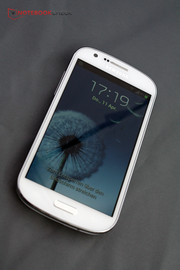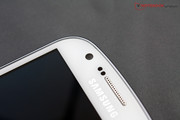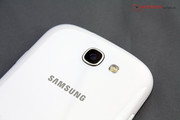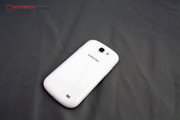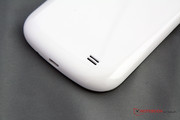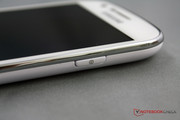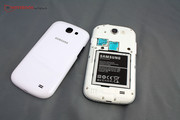Review Samsung Galaxy Express GT-I8730 Smartphone

For the original German review, see here.
Samsung’s smartphone family grows steadily: The Korean manufacturer currently offers 41 different models – not even including its famous phablets. One reason for this is that Samsung barely ever removes any smartphones from the market, thus offering models for almost every niche ranging from rugged outdoor phones to juvenile phones.
We are testing the mid-range Samsung Galaxy Express which currently costs around $450 (RRP: $599). Its name supposedly derives from its LTE capability. Other unique selling points are its AMOLED-Plus display and its large 2000 mAh battery.
Mid-range Android smartphones are a dime a dozen. One potential competitor of the Galaxy Express might be the HTC One SV, which is also LTE-capable, using the exact same system-on-a-chip as Samsung. A non-Android alternative is the Nokia Lumia 820 running on Windows Phone 8. Most other devices in this price range do not come equipped with LTE, for example the Google Nexus 4 which offers a great value-for-money ratio. The Sony Xperia T and the Huawei Ascend D1 are two more mid-range competitors. Let us see, whether its LTE capabilities turn the Samsung Galaxy Express into a bargain buy.
As mentioned before, the case of the Samsung Galaxy Express resembles closely that of the Samsung Galaxy S3. Only the speaker moves down a bit on the back, while both the front camera and the ambient light sensor are shifted to the other side on the front. In addition, the screen of the Galaxy Express is 0.3 inches smaller than that of the Galaxy S3, yielding a reduced device height and width. Still, the Galaxy Express is thicker by 0.5 millimeters and also heavier by 5 grams.
Our test device is currently only available in white. It is definitely a slick smartphone: As with the Galaxy S3, a chrome-colored frame runs along its sides and its round, almost organic shape helps set its design apart from Apple. Its surface feels great, even though the backside acts as a fingerprint-magnet.
Build quality is very good, despite Samsung's choice of materials (plastic). The rear panel can be removed completely. It is very thin, light and can be bent, but this is not noticeable once it snaps back onto the base unit. Indeed, the Samsung Galaxy Express feels very sturdy and cannot be bent out of shape.
The Samsung Galaxy Express is powered by a Qualcomm system-on-a-chip which includes a Snapdragon S4 MSM8930 processor clocked at 1.2 GHz as well as an Adreno 305 GPU. The same SOC has been used in the HTC One SV, being classified by us as offering mid-range performance.
The Galaxy Express comes with 8 GB of flash storage, but only 4.69 GB of it is available for the user. This might be too little for some users, especially if many apps are to be installed. Still, hidden beneath the back panel lies a micro SD card slot so that up to 32 GB of external memory is possible.
The volume rocker can be found on the left side of the smartphone. At the top, there is a 3.5mm Line In/Out port, on the right, the On/Off/Standby button can be found while the micro USB port sits at the bottom.
Software
All Galaxy series smartphones rely on Google's Android platform - including the Galaxy Express, which comes with Android 4.1.2 Jelly Bean preinstalled. Despite the availability of Android 4.2, Samsung has not yet managed to use the newer software version in most of its devices.
Much of the operating system remains unchanged apart from Samsung's typical TouchWiz interface and a few interesting apps and widgets: Flipboard arranges the user's messages from all activated social media (and other) accounts within one magazine-style app and comes with a widget. S Voice is Samsung's version of Siri, working almost as well as Apple's counterpart. AllShare Play allows the user to send content effortlessly to connected devices such as TVs or notebooks.
Unfortunately, there is also much unnecessary bloatware, apps, which have to be bought after an initial test phase or which can only be used with a subscription-based video streaming service. This quickly becomes annoying even after booting for the first time - Samsung should think twice about whether it wants to continue with such a disservice.
Communication & GPS
There is nothing to complain about with the numerous connectivity options the Galaxy Express offers. Most importantly, of course, it supports superfast LTE networks. With the right contract, up to 100 Mbit/s downstream and up to 50 Mbit/s upstream can be reached. The Galaxy Express supports all four GSM frequencies. Thus, it can be used in almost every single country in the world to make telephone calls. Its Wi-Fi modem supports both the 2.4 GHz and the less common 5 GHz bands. NFC and the new Bluetooth 4.0 standard are also on board.
The GPS sensor is very reliable and fast in finding enough satellites for a precise location. Of course, this only works outdoors - when no satellites can be found, the smartphone falls back to its mobile signal and Wi-Fi-based location services.
Telephone Functions
The telephone app of Google Android works very well, so why change it? Accordingly, all Samsung does is to tweak some colors. People who are used to Android will immediately feel at home here, but even newcomers won't have any trouble making their first call. All contacts stored within the user's Google account will be loaded automatically.
Cameras & Multimedia
There is both a 5 megapixel camera with autofocus and an LED flash on the back and a 1.2 megapixel front camera for video calls. This is on par with most mid-range devices, still, the HTC One SV's front camera offers a slightly higher resolution.
Pictures made by the main camera are quite sharp at a first glance, but lack some punch in terms of color rendition. Zooming in reveals some fuzziness, somewhat mitigating the initial impression of its sharpness. The front camera also yields slightly dull and blurry pictures. The main camera is capable of taking videos with a nominally smooth frame rate of 25 fps, but they stutter during swift panning motions.
The Samsung Galaxy Express is capable of handling a large variety of video formats, both streamed from the internet and stored locally. Jumping to a different part of the video rarely causes noticeable delays. The high contrast ratio and vibrant colors of the screen in combination with more than decent speakers result in a joyful video experience.
Accessories
The smartphone ships with nothing but the obligatory headphones. There are many accessories on Samsung's website, however, the website is confusingly designed. Apart from replacement batteries and the new universal docking stations (which also work with non-Samsung devices thanks to their micro USB connections), numerous headsets, car device cradles, bags and much more can be bought, though it might be prudent to compare their prices with those of third-party offerings.
Warranty
The Galaxy Express ships with 24 months of warranty. In case of a malfunction, the device must be returned to the vendor. Alternatively, Samsung's hotline may be utilized. An overview over authorized Samsung service partners for repairs can be found on Samsung's website. No warranty extension for smartphones is offered from Samsung itself.
Input Devices & Controls
The virtual keyboard is just Google's standard design. If this is deemed unsatisfying, many alternatives can be found in the Google Play Store. Still, even the standard keyboard offers many settings and we felt that typing was fast and unproblematic. Switching between the landscape and portrait modes of the keyboard was also rather swift, leading to a satisfying workflow.
Samsung has been using AMOLED displays in its smartphone lineup for ages. These screens consist of many organic light emitting diodes which don't rely on any background lighting, yielding better contrast ratios, more saturated colors and decreased power consumption. The main disadvantage of AMOLED displays lies with their shorter lifetimes and a reduction in luminance over time - still, with typical smartphone lifecycles of around 2 years this shouldn't have any significant effects.
The AMOLED display of the Galaxy Express offers a resolution of 800x480 pixels (thus sporting an aspect ratio of 16:9) and a screen size of 4.5-inches. Its resolution is the same as those of some other mid-range phones such as the Huawei Ascend D1, the Nokia Lumia 820 or the HTC One SV, while both the Google Nexus 4 and the Sony Xperia T offer a resolution of 720p for the same price.
AMOLED displays are almost never as bright as classical LED displays (accordingly, the Samsung Galaxy S3 was a lot dimmer than the iPhone 5 for example), and the Samsung Galaxy Express is no exception to this rule. Actually, it is worse off than all of its competitors, achieving 258.2 cd/m². The best by far among the direct competition is the Sony Xperia T with an average brightness of 470.1 cd/m².
| |||||||||||||||||||||||||
Brightness Distribution: 85 %
Center on Battery: 258 cd/m²
Contrast: 6450:1 (Black: 0.04 cd/m²)
Contrast is usually a strong suit of AMOLED displays, since they are capable of simply turning pixels off, rendering a true black without any backlighting. Accordingly, the black levels of the Samsung Galaxy Express are formidable with just 0.04 cd/m², yielding a contrast ratio of 6450:1. Only other OLED-devices like the Nokia Lumia 820 come close. At least nominally, even high-end devices such as the iPhone 5 fall behind.
During real-life usage, colors were vivid, contrast was strong and blacks were indeed very dark. Everything is very sharp and quite brilliant - if we didn't know about the resolution of 800x480 pixels, we would grade it higher than it actually is.
Below, we have posted screenshots of our color analysis done with CalMAN software and a colorimeter. Reds have the worst color accuracy. Blues are strongly under-saturated - this is probably done on purpose to guarantee a long-time steadiness of image quality, since blue pixels age faster than their green and red counterparts.
The Samsung Galaxy Express comes equipped with a Qualcomm SOC which includes a Snapdragon S4 Plus MSM8930 with two cores and a CPU clock speed of 1.2 GHz as well as an Adreno 305 graphics chip. With these components, the Galaxy Express manages to secure a place in the upper mid-range of our competitors. It is not as fast as the Google Nexus 4, but we noticed neither any stuttering nor lags, thus the Express moniker of Samsung's smartphone seems well-deserved.
| AnTuTu v3 - Total Score (sort by value) | |
| Samsung Galaxy Express GT-I8730 | |
| Google Nexus 4 | |
| HTC One SV | |
| Geekbench 2 - 32 Bit - Total Score (sort by value) | |
| Samsung Galaxy Express GT-I8730 | |
| Google Nexus 4 | |
| HTC One SV | |
| Sony Xperia T | |
| Huawei Ascend D1 Quad XL | |
| Linpack Android / IOS - Multi Thread (sort by value) | |
| Samsung Galaxy Express GT-I8730 | |
| Google Nexus 4 | |
| HTC One SV | |
| Sony Xperia T | |
| Huawei Ascend D1 Quad XL | |
The graphics chip has already demonstrated its laudable performance during our review of the HTC One SV, but again, it does not beat the Google Nexus 4. Rather, it remains on par with the HTC phone, staying slightly ahead of both the Sony Xperia T and the Huawei Ascend D1.
More demanding benchmarks like 3DMark or GLBenchmark 2.7 end in a stuttering mess. During GLBenchmark 2.7 our test device didn't manage to exceed an average of 12 frames per second, while the benchmark ran much more smoothly on a Google Nexus 4 with 20 fps. Luckily, most applications and even games shouldn't put such a strain on the GPU.
| AnTuTu 3DRating - --- (sort by value) | |
| Samsung Galaxy Express GT-I8730 | |
| Google Nexus 4 | |
| HTC One SV | |
| GFXBench (DX / GLBenchmark) 2.7 - T-Rex Onscreen (sort by value) | |
| Samsung Galaxy Express GT-I8730 | |
| Google Nexus 4 | |
| GLBenchmark 2.5 - Egypt HD Fixed Time (sort by value) | |
| Samsung Galaxy Express GT-I8730 | |
| Google Nexus 4 | |
| HTC One SV | |
| Sony Xperia T | |
| Huawei Ascend D1 Quad XL | |
| 3DMark - 1280x720 Ice Storm Standard Score (sort by value) | |
| Samsung Galaxy Express GT-I8730 | |
| Google Nexus 4 | |
Synthetic browser benchmarks also place the Samsung Galaxy Express in the upper mid-range. Browsing the web felt fast and smooth, with another potential speed increase if alternative browsers are downloaded from the Google Play Store.
| Google V8 Ver. 7 - Google V8 Ver. 7 Score (sort by value) | |
| Samsung Galaxy Express GT-I8730 | |
| Google Nexus 4 | |
| HTC One SV | |
| Nokia Lumia 820 | |
| Sony Xperia T | |
| Huawei Ascend D1 Quad XL | |
| Octane V1 - Total Score (sort by value) | |
| Samsung Galaxy Express GT-I8730 | |
| Google Nexus 4 | |
| Nokia Lumia 820 | |
| Peacekeeper - --- (sort by value) | |
| Samsung Galaxy Express GT-I8730 | |
| Google Nexus 4 | |
| HTC One SV | |
| Nokia Lumia 820 | |
Its flash memory, which is one of the faster varieties, is second to none but (again) the Google Nexus 4.
Games
As mentioned, the Qualcomm Adreno 305 is a mid-tier graphics solution which should be sufficient for most recent mobile games. Despite failing the more demanding 3D benchmarks, casual games such as Angry Birds: Star Wars or Temple Run run smoothly. We didn't even notice any lag in action games such as Zombiewood or Shadow Gun: Dead Zone, a sophisticated 3D shooter. Gamers will also be glad to hear that touchscreen reaction was both fast and reliable.
Temperature
In the case of smartphones, the case temperature is even more important than with notebooks or tablets, since the device is almost exclusively held in its user's hands. Samsung has delivered very good work in this regard: Even under full load, temperatures never exceed 33.6 °C, while next to no temperature increase (up to 29.2 °C) occurs when the smartphone remains idle.
A comparison with its competitors reveals a considerable difference. None of them get uncomfortably hot, but still, the Nokia Lumia 820 for example reaches 48 °C under full load with none of the other smartphones staying below 38 °C.
(+) The maximum temperature on the upper side is 33.5 °C / 92 F, compared to the average of 35.2 °C / 95 F, ranging from 21.9 to 247 °C for the class Smartphone.
(+) The bottom heats up to a maximum of 33.6 °C / 92 F, compared to the average of 33.9 °C / 93 F
(+) In idle usage, the average temperature for the upper side is 28.5 °C / 83 F, compared to the device average of 32.9 °C / 91 F.
Speakers
The tiny speaker on the lower backside offers decent sound quality. Only at maximum volume do high-pitched sounds begin to roar, otherwise music and videos sound rich and lush. Hands-free call quality is good enough to easily understand one's counterpart.
Voice Quality
The Samsung Galaxy Express offers very good voice quality, directly via the phone's speaker as well as when using the included headset. Speech can always be understood well without being distorted by ambient noise.
Power Consumption
Despite its decent performance, the Samsung Galaxy Express is not very power-hungry. Exactly the opposite is true: Power consumption levels are less than they are for all its competitors. Power consumption levels of up to 2.2 watts under full load are less than for all its competitors - a nice surprise since the HTC One SV (which is equipped with the same CPU and GPU) uses at least 40% more power in all situations. This difference is probably due to the AMOLED display used in the Samsung Galaxy Express. Thus - in combination with the extra-large battery - these low power consumption levels should help the Galaxy Express to excel in terms of battery life.
| Off / Standby | |
| Idle | |
| Load |
|
Key:
min: | |
Battery Runtime
12:30 hours while idle is just average. The true strengths of the Samsung Galaxy Express are revealed in the Wi-Fi test which comes close to actual usage, with new websites being opened once or twice per minute. It takes 10:30 hours until the battery finally dies. This is superb, and far better than what most of the competition achieve. Only the Nokia Lumia 820 exceeds these 10:30 hours, running up to 12 hours. But it gets even better, especially so for mobile gamers: Under full load, the Samsung Galaxy Express manages to squeeze up to 5:33 hours out of its battery, much more than all its competitors.
The Samsung Galaxy Express offers a lot of what we like to see in a smartphone: A brilliant display, great battery life and high application and gaming performance. Many of its competitors can’t keep up with the Galaxy Express, although some are ahead in terms of build quality and screen resolution.
There are still just a few LTE-enabled devices out there, letting the Galaxy Express stand out even more. In the same price range, only the HTC One SV and the Nokia Lumia 820 offer similar data transfer speeds. Those who don’t want to switch to the also rather intuitive Windows Phone 8 OS can only choose between the HTC One SV and the Samsung Galaxy Express. The HTC’s build quality is better, but the Galaxy Express offers a larger display and slightly superior battery life. Still, these differences are just marginal so that it ultimately comes down to personal preference.
The only counterarguments against the Samsung Galaxy Express are centered on its low display resolution and its color choice – only a white model is available at the time of writing. Still, if LTE is deemed important and if money is tight, then it doesn’t seem possible to go wrong with this smartphone – in this case, we can recommend the Samsung Galaxy Express full-heartedly.









